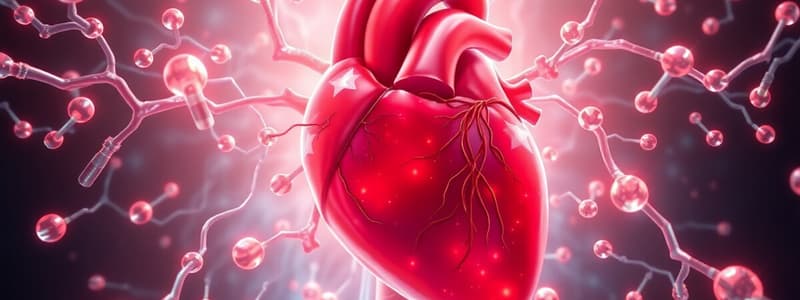Podcast
Questions and Answers
Which of the following statements correctly describes the primary mechanism of milrinone's action?
Which of the following statements correctly describes the primary mechanism of milrinone's action?
- Milrinone blocks the action of sodium-calcium exchangers, leading to increased intracellular calcium concentration.
- Milrinone inhibits the breakdown of cyclic AMP (cAMP), resulting in enhanced myocardial contractility and vasodilation. (correct)
- Milrinone binds to and activates beta-adrenergic receptors, increasing heart rate and contractility.
- Milrinone directly stimulates calcium release from the sarcoplasmic reticulum, leading to increased contractility.
A patient with severe aortic regurgitation is experiencing acute heart failure. Which of the following medications would be MOST appropriate for this patient, considering their condition?
A patient with severe aortic regurgitation is experiencing acute heart failure. Which of the following medications would be MOST appropriate for this patient, considering their condition?
- Dobutamine (correct)
- Dopamine
- Milrinone
- Digoxin
A patient receiving milrinone develops new-onset atrial fibrillation. What is the MOST likely explanation for this adverse effect?
A patient receiving milrinone develops new-onset atrial fibrillation. What is the MOST likely explanation for this adverse effect?
- Atrial fibrillation is a known consequence of increased intracellular cAMP levels.
- The patient's underlying heart disease may be the primary cause of the atrial fibrillation, and milrinone is not directly responsible. (correct)
- Atrial fibrillation is a common side effect that occurs in the majority of patients receiving milrinone.
- Milrinone directly induces atrial fibrillation.
Why is frequent monitoring and dose adjustment necessary for patients receiving milrinone?
Why is frequent monitoring and dose adjustment necessary for patients receiving milrinone?
A patient presents with severe hypotension and cardiogenic shock. Which statement accurately reflects the use of milrinone in this scenario?
A patient presents with severe hypotension and cardiogenic shock. Which statement accurately reflects the use of milrinone in this scenario?
Which of the following factors would MOST likely contraindicate the use of milrinone in a patient with acute heart failure?
Which of the following factors would MOST likely contraindicate the use of milrinone in a patient with acute heart failure?
A patient is receiving milrinone and exhibits tremors. Which of the following is the MOST appropriate action?
A patient is receiving milrinone and exhibits tremors. Which of the following is the MOST appropriate action?
Which of the following scenarios MOST strongly suggests a need for an alternative inotropic agent instead of milrinone?
Which of the following scenarios MOST strongly suggests a need for an alternative inotropic agent instead of milrinone?
What is the primary purpose of continuous blood pressure monitoring?
What is the primary purpose of continuous blood pressure monitoring?
What key parameter is vital in determining the dosage of milrinone for a patient?
What key parameter is vital in determining the dosage of milrinone for a patient?
Which of the following actions is crucial for nurses when administering milrinone?
Which of the following actions is crucial for nurses when administering milrinone?
What potential side effect should patients be instructed to monitor when receiving milrinone?
What potential side effect should patients be instructed to monitor when receiving milrinone?
Why is it important to be aware of drug interactions when administering milrinone?
Why is it important to be aware of drug interactions when administering milrinone?
Flashcards
Continuous Blood Pressure Monitoring
Continuous Blood Pressure Monitoring
Essential for tracking patient stability and response to treatment.
Milrinone Dosage
Milrinone Dosage
Administered intravenously, tailored to individual patient needs and effects.
Hemodynamic Parameters
Hemodynamic Parameters
Includes cardiac output and stroke volume; vital for assessing heart function.
Drug Interactions
Drug Interactions
Signup and view all the flashcards
Patient Education on Side Effects
Patient Education on Side Effects
Signup and view all the flashcards
Milrinone
Milrinone
Signup and view all the flashcards
Positive Inotropic Effect
Positive Inotropic Effect
Signup and view all the flashcards
Phosphodiesterase III Inhibition
Phosphodiesterase III Inhibition
Signup and view all the flashcards
Short half-life
Short half-life
Signup and view all the flashcards
Clinical Indications
Clinical Indications
Signup and view all the flashcards
Common Side Effects
Common Side Effects
Signup and view all the flashcards
Contraindications
Contraindications
Signup and view all the flashcards
Study Notes
Overview
- Milrinone is a positive inotropic agent.
- It increases the force of myocardial contraction.
- It's used in acute heart failure and cardiogenic shock.
- It's a phosphodiesterase inhibitor.
- It works by increasing intracellular cAMP levels.
- It's administered intravenously.
- It has a relatively short half-life.
- Side effects include tremors, nausea, and arrhythmias.
- It's primarily used when other inotropic agents are ineffective or inappropriate.
Mechanism of Action
- Milrinone is a potent phosphodiesterase III inhibitor.
- Phosphodiesterase III is an enzyme that breaks down cyclic AMP (cAMP) in the myocardium.
- By inhibiting this enzyme, milrinone causes an increase in the intracellular cAMP levels.
- This elevation in cAMP leads to an increased calcium sensitivity in the myocardial contractile proteins.
- Resulting in enhanced myocardial contractility (positive inotropic effect).
- Milrinone also promotes vasodilation, reducing afterload.
Pharmacokinetics
- Milrinone is given intravenously.
- Initial dose is typically 0.5-0.75 mcg/kg/min, titrated up to desired response.
- It has a relatively short half-life (approximately 10 minutes).
- Its metabolites are also reported to be active but with longer half-lives.
- This short half-life requires frequent monitoring and dose adjustments.
- Elimination occurs primarily through hepatic metabolism.
Clinical Indications
- Milrinone is used primarily in acute heart failure and cardiogenic shock.
- It is particularly helpful in situations where other inotropic agents are ineffective or contraindicated.
- It is used in combination with other therapies such as diuretics and vasodilators.
Contraindications and Precautions
- Severe hypotension
- Ventricular arrhythmias
- Severe aortic or mitral regurgitation
- Recent myocardial infarction
- Hypersensitive to the medication.
Side Effects
- Common side effects include:
- Tremors
- Nausea
- Headache
- Arrhythmias (atrial fibrillation or ventricular tachycardia)
- Hypotension
- Peripheral vasoconstriction
- Less frequent but potentially serious side effects are:
- Thrombocytopenia
- Liver dysfunction
- Kidney injury
Interactions
- Concurrent use with other positive inotropes can increase the risk of side effects.
- Agents that enhance cAMP levels and those that inhibit phosphodiesterase, such as some other inotropes.
- Some other medications may interfere with metabolism (e.g., strong CYP3A4 inhibitors).
Monitoring Parameters
- Continuous blood pressure monitoring is essential.
- Frequent electrocardiogram monitoring to detect arrhythmias.
- Hemodynamic parameters, such as cardiac output and stroke volume, need to be closely monitored.
- Laboratory tests to assess potential adverse effects on various organ systems (e.g. hepatic and renal functions, platelet counts).
Dosage
- Milrinone is administered intravenously.
- Dosage is based on individual patient needs and should be titrated to achieve desired hemodynamic effect.
- There is no standard dosage; it is adjusted based on response.
Drug Interactions
- Be aware of interactions with other medications known to affect cardiac function or metabolism.
- The potential for drug interactions necessitates careful attention to patient history and concomitant medications.
Nursing Considerations
- Proper administration techniques and careful monitoring are required.
- Nurses need to recognize and address any potential complications related to use, such as arrhythmias or hypotension.
Patient Education
- Patients should be instructed on potential side effects to watch for, and when to notify healthcare providers.
- Patients need to understand the importance of regular follow-up monitoring.
Studying That Suits You
Use AI to generate personalized quizzes and flashcards to suit your learning preferences.




